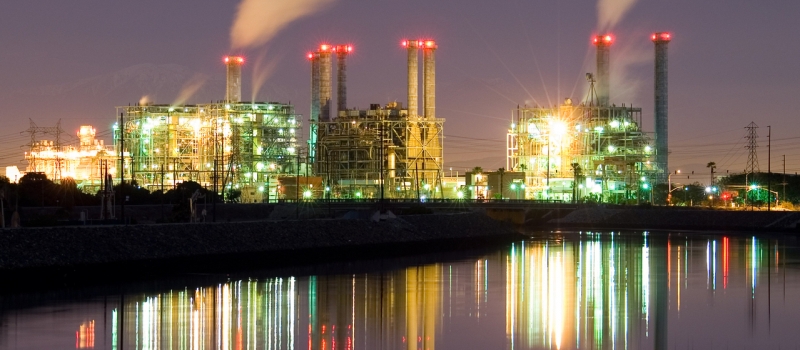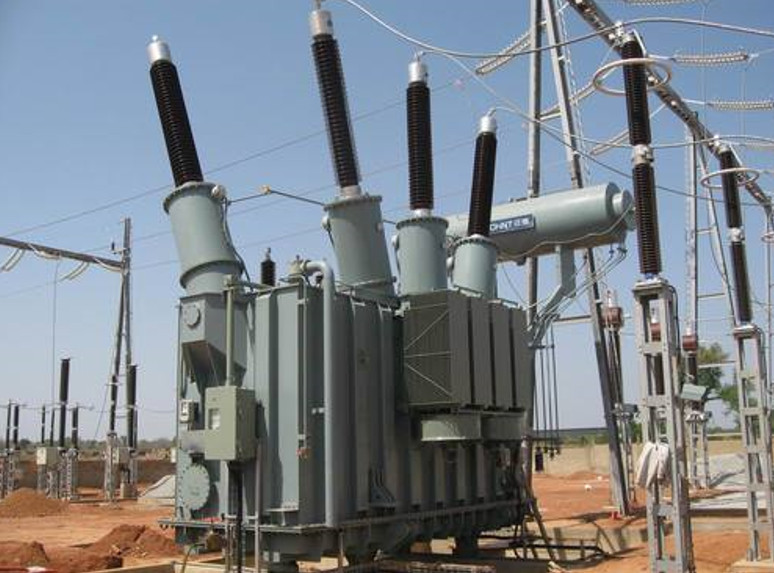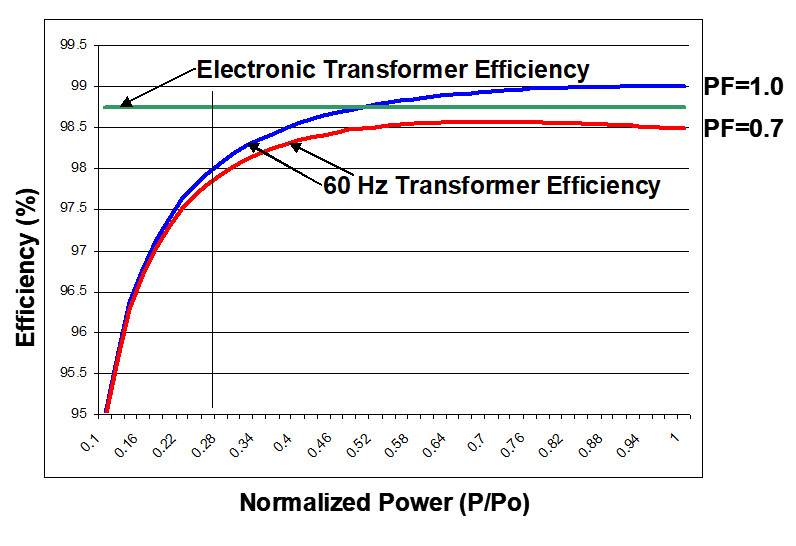
The Resonant Link power converters can be utilised for practically any electrical utility power control, voltage regulation and reactive power (VAR) applications.
Resonant Link technology is an ideal technology for present and future electrical networks.
In addition to power regulation however, Resonant Link converters, irrespective of the application, can safety turn off power to AC or DC loads within one millisecond to prevent current short currents or to facilitate load shedding.
Some areas of applications are discussed below :
Traditional AC Grid Applications
The traditional AC grid system which has been in operation since the late 19th Century has many weaknesses but has been maintained due to the ease of transforming AC voltages and transmitting that voltage over long distances via electro-magnetic transformers.
A serious concern for many years is that standard electro-magnetic AC to AC transformers (see above) require constant magnetization which reduces their overall transformer efficiency to about 95% (based on an average daily load factor of 30%).
Resonant Link active (electronic) transformers have an efficiency of >98.5% over the full load range (see above). The additional >3.5% real world efficiency yields to the utility, financial savings of $525 per kVA over the working life of the transformer, assumed at 20 years.
For a 2500kVA transformer therefore savings would be in the order of US$ 1,312,500 whilst the cost of a new Resonant Link active transformer is US$ 50 per kVA so the replacement cost of the 2500kVA conventional transformers with an active type would be around US$ 125,000 with additional significant savings in running cost going forward.
Resonant Link active transformers, in addition to virtually eliminating magnetisation losses, provides AC output voltage regulation to 0.1%, even with large input voltage swings (i.e. sags or surges). Since the sinusoidal AC voltage waveforms are reconstructed, the voltage harmonics on the input side the transformer are blocked (i.e. no background Uthd is visible on the output).
Resonant Link AC-AC active transformers can also interconnect independent grid systems and transform voltages from one independent power system to another, even if they have differing frequencies, phases, and voltages. Also, stated earlier, the active transformer can also be configured as a VAR compensator, requiring no transformer isolation.
The replacement of conventional transformers certainly should be of significant interest to any power company, especially when the additional benefits of short circuit protection with one millisecond, voltage regulation and reactive power control are already built-in to the Resonant Link active transformers
Renewable Energy Injection and Imbedded DC transmission
Wind, tidal and solar energy injection often causes AC voltage and VAR support instability if standard PWM IGBT converters (see below) are used for AC grid connection.
As intimated in the section on ‘renewables’ on this website, Resonant Link converters can connect wind or tidal power into any the grid system with controlled VAR support and regulated voltage. AC wind or tidal generator outputs can be at any frequency with significant voltage variation. With Resonant Link the power injection can be precisely regulated without harmonics (THDi <2%), common mode voltage or VAR issues.
Please refer to the section of ‘renewables’ on this website for further information on the conversion, energy gathering and transmission of wind and tidal energy.
The solar generated DC power can be stepped-up in voltage by DC-AC active transformers and transmitted to the AC grid where it is injected any with the necessary VAR support (also provided by the active transformer). Resonant Link DC-DC power conversion can be used for imbedded DC power transmission where the power flow can be bi-directional. Resonant Link can also covert AC voltage to DC voltage for transmission over considerable distances and reconstruct the AC voltage at the receiving end without harmonics (<2% THDi).
In wind and tidal renewable energy systems space is often a premium. It should be stated therefore that Resonant Link converters are around require <15-20% of the space required for conventional PWM converters. Also, conventional transformers are not required, again saving valuable space, nor AC and DC breakers for short-circuit protection. Common mode voltage (between each phase and ground) can be a serious issue on PWM converters. Resonant Link does not produce any common mode issues as it is soft switching; the output voltage and current are both sinusoidal (THDi <2%) and a du/dt of <20/μs at MV which is 1000th less than PWM converters at the same voltage level.
Future Grid Configuration
Due to US military and US Government policies it is clear that the future US grid will mainly DC based. However, a large amount of power will still be still produced for AC rotating machinery but in the future their frequency and voltage will be completely flexible. Renewable power generation will start to dominate and can be readily integrated into selected DC transmission and distribution grid voltages. Resonant Link AC to DC, DC to AC conversion and DC to DC transformation is ideally position to partake in this electrical grid revolution.
Industrial and domestic power consumption will also be mainly in DC. This includes the input power to DC to AC motor drive converters (i.e. inverter sections only as intimated also in the section on Marine DC power systems). It may be advantageous to select a plus (+) and minus (-) 220 V DC consumer power distribution system; the standard household loads being 220VDC, whilst the 440VDC loads can be used for small to medium motor drives and other industrial loads. The present 115VAC loads in the US would be phase out, since larger diameter cable are required to carry their heavier current.
In a future grid, Resonant Link converters could rectify the generated AC voltage to around 18kVDC for transmissions to substations from where the DC to DC active transformers would step the voltage up plus (+) and minus (-) 100kVDC for further transmission and distribution. At the receiving end of the distribution system the DC voltage would be stepped down to the 18kV DC substation voltage level and further stepped down to the appropriate industrial and consumer voltage levels.
Low cost, extruded polypropylene DC cables, available to over 500kVDC, facilitates economic DC transmission and distribution. The majority of these cables would be buried underground thus addressing a major concern by the US government in that a single nuclear EMP (electro-magnetic pulse) blast in the atmosphere could result in the entire US power grid could be knocked. This would be the case if only above ground transmission was used. For more information on the transition to DC and hardened military and grid systems please refer to the section on ‘Defence Systems’ on this website.
Utilising Resonant Link conversion, transmission and distribution systems, whole continents have the possibility of interconnection. Energy storage, a priority of the future however must be increasingly developed and efficiently implemented to ensure optimum energy management and use for all.




